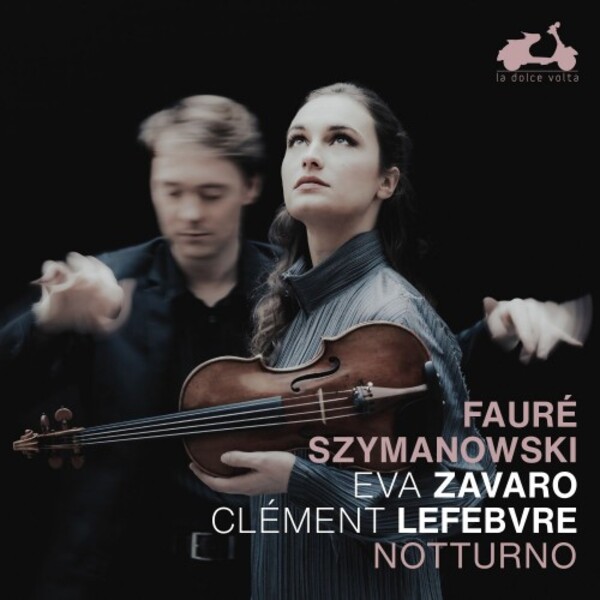FAURÉ; SZYMANOVSKI 'Notturno' (Eva Zavaro)
View record and artist detailsRecord and Artist Details
Genre:
Chamber
Label: La Dolce Volta
Magazine Review Date: 01/2025
Media Format: CD or Download
Media Runtime: 64
Mastering:
DDD
Catalogue Number: LDV127

Tracks:
| Composition | Artist Credit |
|---|---|
| Sonata for Violin and Piano |
Karol Szymanowski, Composer
Clément Lefebvre, Piano Eva Zavaro, Violin |
| Berceuse |
Gabriel Fauré, Composer
Clément Lefebvre, Piano Eva Zavaro, Violin |
| Sonata for Violin and Piano No. 2 |
Gabriel Fauré, Composer
Clément Lefebvre, Piano Eva Zavaro, Violin |
| Lullaby, '(La) berceuse d'Aïtacho Enia' |
Karol Szymanowski, Composer
Clément Lefebvre, Piano Eva Zavaro, Violin |
| Nocturne and Tarantella |
Karol Szymanowski, Composer
Clément Lefebvre, Piano Eva Zavaro, Violin |
| (3) Songs, Movement: No. 1, Après un rêve (wds. anon, trans Bussine |
Gabriel Fauré, Composer
Clément Lefebvre, Piano Eva Zavaro, Violin |
Author: Aleksander Laskowski
The concept for this album is very interesting, with a combination of pieces created at a time when the long-established Romantic notion of the musical self was finally destabilising under a burden of neurosis and chromatic harmony. It begins with Karol Szymanowski’s Sonata in D minor for violin and piano, Op 9, which was written in 1904, when Szymanowski was still infatuated with German music: Brahms’s violin sonatas are the obvious reference. The work was premiered in Warsaw in 1909 by Szymanowski’s close friends Paweł Kochański and Arthur Rubinstein. The other big piece on the album is Fauré’s Second Violin Sonata in E minor, Op 108. Written in 1916 and premiered in 1917 by Louis Capet with the composer at the piano, it was dedicated to Queen Elisabeth of Belgium, herself a keen violinist who was fond of Fauré’s music. It is surprising how much a late work by Fauré, a true but ageing Romantic, and an early composition by Szymanowski, a young and dedicated modernist, actually have in common, with emotions running high and complex harmony defining the character of both pieces. Both sonatas are performed with a beautiful sound and much élan, although I miss the vibrant intensity one hears from Zino Francescatti and Robert Casadesus or the inner emotional drive of Kaja and Justyna Danczowska on their Polish Radio Szymanowski album.
In the CD booklet Eva Zavaro explains that the idea of programming Fauré and Szymanowski together came from a poetic revelation: ‘I perceived that these two composers possessed a shared sensibility, a bond founded on the theme of night.’ When he was composing his Second Violin Sonata, Fauré was suffering from hearing problems, which Zavaro describes as an ‘acoustic night’. And the theme of night was indeed very important for Szymanowski in many of his works. In Notturno and Tarantella, Op 28, one can hear clear references to Spanish and gypsy music. The witty and fiendishly difficult virtuosity here is informed by Szymanowski’s fondness for alcohol, consumed at night, as attested by his friend August Iwański, in whose residence in Ryżawka the piece was partly composed: ‘It was from a bottle of savoury drink that the unceremonious guests took from the cupboard … that his excellent humour sprang most unexpectedly, which was then expressed in the Tarantella.’ Zavaro and pianist Clément Lefebvre impress with their virtuosity but keep the listener more on the sober side. Both lullabies on this album – Fauré’s Op 16 and Szymanowski’s Op 52 – are performed beautifully. The album ends with Fauré’s ‘Après un rêve’, which, as the performers say, adds to this album a Proustian ‘madeleine’, thus revealing the most familiar side of the composer, who was a great master of the tuneful melody.
Discover the world's largest classical music catalogue with Presto Music.

Gramophone Digital Club
- Digital Edition
- Digital Archive
- Reviews Database
- Full website access
From £8.75 / month
Subscribe
Gramophone Full Club
- Print Edition
- Digital Edition
- Digital Archive
- Reviews Database
- Full website access
From £11.00 / month
Subscribe
If you are a library, university or other organisation that would be interested in an institutional subscription to Gramophone please click here for further information.




